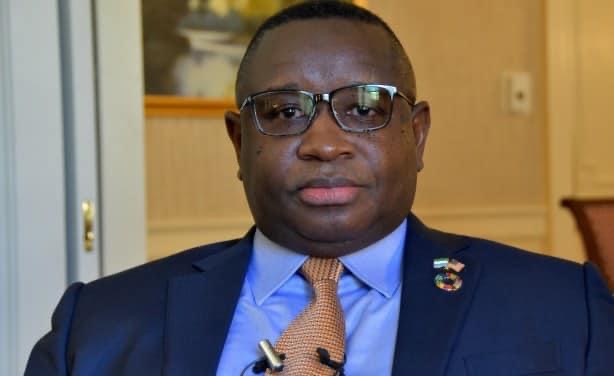
2021 Fiscal Transparency Report
Government-by-Government Assessments: Sierra Leone
During the review period, the government’s budget and information on debt obligations, with the exception of state-owned enterprise debt, were widely and easily accessible to the public, including online. The budget was substantially complete and generally reliable. The supreme audit institution meets international standards of independence. It reviewed the government’s accounts and made its reports publicly available. The process for allocating licenses and contracts for natural resource extraction was outlined in law but not followed in practice. Basic information on natural resource extraction awards was not publicly available. Sierra Leone’s fiscal transparency would be enhanced by:
- disclosing state-owned enterprise debt;
- following in practice procedures for awarding natural resource extraction contracts; and
- making basic information on natural resource extraction awards publicly available.
BUREAU OF ECONOMIC AND BUSINESS AFFAIRS JUNE 25, 2021
Fiscal transparency informs citizens how government revenues and tax revenues are spent and is a critical element of effective public financial management. Transparency provides citizens a window into government budgets and helps hold governments accountable. It helps build market confidence and sustainability. The Congressionally mandated Fiscal Transparency Report (FTR) is a tool to identify deficiencies and support needed changes.ShareIN THIS SECTION /CONCLUSIONS OF REVIEW PROCESS
2021 Fiscal Transparency Report
U.S. DEPARTMENT OF STATE 2021 FISCAL TRANSPARENCY REPORT PURSUANT TO SECTION 7031(b) OF THE DEPARTMENT OF STATE, FOREIGN OPERATIONS AND RELATED PROGRAMS APPROPRIATIONS ACT, 2021 (DIV. K, P.L. 116-260)
SUMMARY
The Department of State (Department) hereby presents the Fiscal Transparency Report pursuant to section 7031(b) of the Department of State, Foreign Operations and Related Programs Appropriations Act, 2021 (Div. K, P.L. 116-260) (FY 2021 SFOAA). The report describes the minimum requirements of fiscal transparency developed, updated, and strengthened by the Department in consultation with other relevant federal agencies. It reviews governments that were originally identified in the 2014 Fiscal Transparency Report and Equatorial Guinea. It assesses those that did not meet the minimum fiscal transparency requirements and indicates whether those governments made significant progress toward meeting the requirements during the review period of January 1 – December 31, 2020. The report also provides a description of the use of FY 2020 and FY 2021 funds through the Fiscal Transparency Innovation Fund.
FISCAL TRANSPARENCY
The Department’s fiscal transparency review process assesses whether governments meet minimum requirements of fiscal transparency. For the purpose of this report, the minimum requirements of fiscal transparency include having key budget documents that are publicly available, substantially complete, and generally reliable. The review includes an assessment of the transparency of processes for awarding government contracts and licenses for natural resource extraction. Fiscal transparency is a critical element of effective public financial management, helps build market confidence, and underpins economic sustainability. Fiscal transparency fosters greater government accountability by providing a window into government budgets for citizens, helping citizens hold their leadership accountable, and facilitating better-informed public debate.
Annual reviews of the fiscal transparency of governments that receive U.S. assistance help ensure U.S. taxpayer funds are used appropriately and provide opportunities to dialogue with governments on the importance of fiscal transparency.
Consistent with section 7031(b)(2) of the FY 2021 SFOAA and the Joint Explanatory Statement accompanying the FY 2020 SFOAA, this report identifies the significant progress made by each government to publicly disclose national budget documentation, contracts, and licenses, which is additional to information disclosed in previous years. It makes specific recommendations of short- and long-term steps such government should take to improve fiscal transparency. Finally, it includes a detailed description of how funds appropriated by the Act are being used to improve fiscal transparency including benchmarks for measuring progress.
Section 7031(b)(1) of the FY 2021 SFOAA requires the Secretary of State to “update and strengthen” minimum requirements of fiscal transparency for each government receiving assistance appropriated by the Act as identified in the 2014 Fiscal Transparency Report. Section 7031(b)(2) further requires the Department to make or update any determination of “significant progress” or “no significant progress” in meeting the minimum requirements of fiscal transparency for each government that did not meet the minimum requirements. Pursuant to Delegation of Authority 513, the Deputy Secretary of State has made those determinations for 2021.
The fiscal transparency determinations may change from year to year due to updating and strengthening minimum requirements of fiscal transparency as required by law, changes in governments’ performance on public financial management, or new information coming to the Department’s attention. As a result, some governments may fall short of these requirements, despite in some cases maintaining or even improving their overall level of fiscal transparency. The report includes a description of how certain governments fell short of the minimum requirements. It outlines any significant progress being made to disclose publicly national budget documentation, contracts, and licenses. It also provides specific recommendations of short- and long-term steps governments should take to improve fiscal transparency. Finally, the report outlines the process the Department followed in completing the assessments and describes how U.S. foreign assistance resources have been used to support fiscal transparency.
While a lack of fiscal transparency can be an enabling factor for corruption, the report does not assess corruption. A finding that a government “does not meet the minimum requirements of fiscal transparency” does not necessarily mean there is significant corruption in the government. Similarly, a finding that a government “meets the minimum requirements of fiscal transparency” does not necessarily reflect a low level of corruption.
FISCAL TRANSPARENCY REVIEW PROCESS AND CRITERIA
The Department has reviewed the minimum requirements of fiscal transparency in consultation with other relevant federal agencies and has updated and strengthened those requirements. The Department assessed the fiscal transparency of the 140 governments identified in the 2014 Fiscal Transparency Report plus Equatorial Guinea, determined whether the minimum requirements were met, and identified any measures those governments that failed to meet the minimum requirements had implemented to make significant progress toward meeting the requirements.
In conducting the 2021 review, the Department assessed the fiscal transparency of governments during the review period of January 1 – December 31, 2020. The Department considered information from U.S. embassies and consulates, other U.S. government agencies, international organizations, and civil society organizations. U.S. diplomatic missions consulted with foreign government officials, international organizations, and civil society organizations to obtain information for these assessments.
In carrying out its evaluation, the Department recognizes specific circumstances and practices of fiscal transparency differ among governments while ensuring minimum fiscal transparency requirements are met in order to enable meaningful public participation in budgeting processes.
MINIMUM REQUIREMENTS OF FISCAL TRANSPARENCY
The Joint Explanatory Statement accompanying the FY 2020 SFOAA defines “minimum requirements of fiscal transparency” to mean the public disclosure of:
- national budget documentation (to include income and expenditures by ministry) and
- government contracts and licenses for natural resource extraction (to include bidding and concession allocation practices).
The 2021 fiscal transparency review process evaluated whether the government publicly disclosed key budget documents, including expenditures broken down by ministry and revenues broken down by source and type. The review process also evaluated whether the government has an independent supreme audit institution or similar institution that audits the government’s annual financial statements, and whether such audits are made publicly available. The review further assessed whether the process for awarding licenses and contracts for natural resource extraction is outlined in law or regulation and followed in practice, and whether basic information on such awards is publicly available. The Department applied the following criteria in assessing whether governments met the minimum requirements of fiscal transparency.
Budget information should be:
- Publicly Available: Budget documents, including the executive budget proposal, enacted budget, and end-of-year report, should be widely and easily accessible to the general public. Complete documents may be available from government offices or libraries, widely available government publications, or mass media channels. Budget documents should be disseminated within a reasonable period of time. A “reasonable period of time” generally corresponds to:
- at least one month before the start of the fiscal year and before budget approval by the legislature for the executive budget proposal,
- within three months of enactment for the enacted budget, and
- within 12 months of the end of the fiscal year for the end-of-year report.
Information on government debt obligations should also be publicly available. The enacted budget and end-of-year report must be available online. Additionally, information on debt obligations must be publicly available and updated at least annually.
Beginning with this review period, if a government has a sovereign wealth fund, it must disclose its source of funding and general approach to withdrawals.
- Substantially Complete: Publicly available budget documents should provide a substantially full picture of the government’s planned expenditures and revenue streams, including natural resource revenues. Budgets should include expenditures broken down by ministry and revenues broken down by source and type. Budget documents should detail allocations to and earnings from state-owned enterprises. If not, such information should be available in other public documents. Significant, large state-owned enterprises should have publicly available audited financial statements. A published budget that does not include significant cash or non-cash resources, including foreign aid, would not be considered substantially complete. Budget documents should incorporate all special accounts or funds. If there are off-budget accounts that have a legitimate purpose, they should be audited, the results made public, and the accounts subject to oversight. Budget documents should also include expenditures to support executive offices or royal families where such expenditures represent a significant budgetary outlay. The review process recognizes military and intelligence budgets are often not publicly available for national security reasons. However, military and intelligence budgets should be approved by the parliament and subject to civilian oversight.Beginning with this review period, debt of all major state-owned enterprises must be disclosed.
- Reliable: Budget documents and related data are considered reliable if the information contained therein is credible, meaning actual government revenues and expenditures correspond to the enacted budget. The government should review budget execution through the course of the year, such as by producing monthly or quarterly budget execution reports. Significant departures from planned receipts and expenditures should be explained in supplementary budget documents and publicly disclosed in a timely manner. Financial statements should be prepared according to internationally accepted principles that yield consistent and comparable statements. The executed budget should be audited by an independent supreme audit institution. The results of such audits, to include an executive summary with findings or recommendations by the supreme audit institution, should be made public within a reasonable period of time (generally within 12 months of the dissemination of the end-of-year report).Beginning with this review period, the government must have a supreme audit institution that meets international standards of independence and verified the government’s annual financial statements.
Natural resource extraction contracting and licensing procedures should be:
- Transparent: The criteria and procedures for the contracting and licensing of natural resource extraction should be publicly available and codified in law or regulation. These laws and regulations should be followed in practice. The basic parameters of concessions and contracts should be made publicly available after the decision. Such information should include the geographic area covered by the contract or license, the resource being developed, the duration of the contract, and the company to which the contract or license is awarded.
SIGNIFICANT PROGRESS OR NO SIGNIFICANT PROGRESS
A determination of “significant progress” indicates that during the review period a government has satisfactorily addressed a key deficiency in meeting the minimum requirements of fiscal transparency. A key deficiency is some material condition or fact that causes a government not to meet the minimum requirements of fiscal transparency.
FISCAL TRANSPARENCY INNOVATION FUND
Section 7031(b)(3) of the FY 2021 SFOAA requires certain funds appropriated under the heading “Economic Support Funds” under title III of the Act be made available for programs and activities to assist governments identified in the fiscal transparency report to improve budget transparency and to support civil society organizations that promote fiscal transparency. In response to a similar requirement, the Department and USAID created the Fiscal Transparency Innovation Fund (FTIF) in Fiscal Year 2012. FTIF supports programs and activities that assist governments to improve their public financial management and fiscal transparency standards and civil society organizations that promote budget transparency. The Department’s Bureau of Economic and Business Affairs and USAID’s Bureau of Development, Democracy, and Innovation solicit proposals and award funds in accordance with established guide. For FY 2021, the Department and USAID plan to support projects to enhance: (1) governments’ capacity to develop and execute comprehensive, reliable, and transparent budgets; (2) citizens’ visibility into state expenditure and revenue programs; and/or (3) citizens’ ability to advocate for specific issues related to government budgets and budget processes.
The Department and USAID are taking the steps necessary to obligate a total of $5 million in FY 2020 Economic Support Funds under the FTIF to support 17 projects, including in the following countries: Algeria, Bahrain, Bangladesh, Democratic Republic of Congo, Equatorial Guinea, Guyana, Haiti, Iraq, Malawi, Niger, Nigeria, Rwanda, Suriname, Tajikistan, and Zambia. Congressional notifications of these funds are forthcoming. The projects are targeted to advance efforts by government and civil society to enhance fiscal transparency and public financial management practices and to improve public awareness and involvement in the expenditure of public resources. (The FTIF may also support projects in South Sudan and Zimbabwe, contingent on addressing applicable restrictions. In addition, projects in Bahrain, Haiti, Iraq, South Sudan, and Zimbabwe require special notification.)
CONCLUSIONS OF REVIEW PROCESS
The Department concluded that, of the 141 governments evaluated, 74 met minimum requirements of fiscal transparency. Two governments, Nigeria and The Gambia, met minimum requirements in 2021 after not meeting minimum requirements in 2020. Sixty-seven governments did not meet the minimum requirements of fiscal transparency. Of these 67, however, 17 governments made significant progress toward meeting the minimum requirements of fiscal transparency.
The Department assessed the following governments as meeting the minimum requirements of fiscal transparency for 2021: Afghanistan, Albania, Argentina, Armenia, Bosnia and Herzegovina, Botswana, Brazil, Bulgaria, Burkina Faso, Cabo Verde, Chile, Colombia, Costa Rica, Côte d’Ivoire, Croatia, Czech Republic, Estonia, Fiji, The Gambia, Georgia, Ghana, Greece, Guatemala, Guyana, Honduras, Hungary, India, Indonesia, Israel, Jamaica, Jordan, Kenya, Kosovo, Kyrgyz Republic, Latvia, Lithuania, Malaysia, Malta, Marshall Islands, Mauritius, Mexico, Micronesia (Federated States of), Moldova, Mongolia, Montenegro, Morocco, Namibia, Nigeria, Nepal, North Macedonia, Panama, Paraguay, Peru, Philippines, Poland, Portugal, Romania, Samoa, Serbia, Seychelles, Singapore, Slovakia, Slovenia, South Africa, Sri Lanka, Thailand, Timor-Leste, Togo, Tonga, Trinidad and Tobago, Tunisia, Turkey, Uganda, and Uruguay.
The following table lists those governments that were found not to meet the minimum requirements of fiscal transparency and identifies whether the governments made significant progress toward meeting those requirements:



